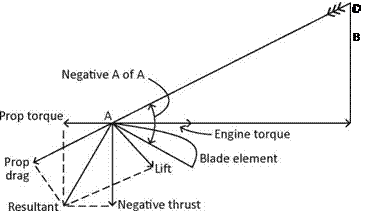Reverse Thrust Forces
Reverse (or negative) thrust is achieved by turning the prop blades about 30 degrees past the fine/flat pitch stop to a negative angle of attack, referred to as braking pitch. In this position, the resultant force is acting in a rearwards direction, the same as when the prop is windmilling. However, during reverse thrust operations, prop torque is acting in the opposite direction to prop rotation opposing the engine torque as
|
The propellers on this Boeing KC-97G Stratofreighter are all parked in the feathered position; this is unusual for a piston-engine aircraft. The aircraft is stored and displayed at the Pima Air & Space Museum, Tucson, Ar. |
shown by Diagram 18, Reverse Thrust Forces. Engine torque is equal and opposite to prop torque acting in the direction from A-B as indicated by the arrowhead. This could cause the prop to attempt to windmill backwards against the power of the engine. The rearward component of the resultant force produces negative thrust to provide a very effective air brake, assisted by the quite considerable prop drag. With the aircraft reducing speed during the landing roll, the vector B-C will reduce. This will cause the negative angle of attack to also reduce, resulting in a decrease in negative thrust. Hence the need to apply reverse thrust early in the landing roll to take advantage of its greatest effect. When operating in the reverse mode, the prop blades are at a negative angle of attack and the prop will be less efficient than at normal forward motion pitch settings. However, full efficiency is not essential due to the brief period reverse is used on the landing roll.
 |
Diagram 18, Reverse Thrust Forces












